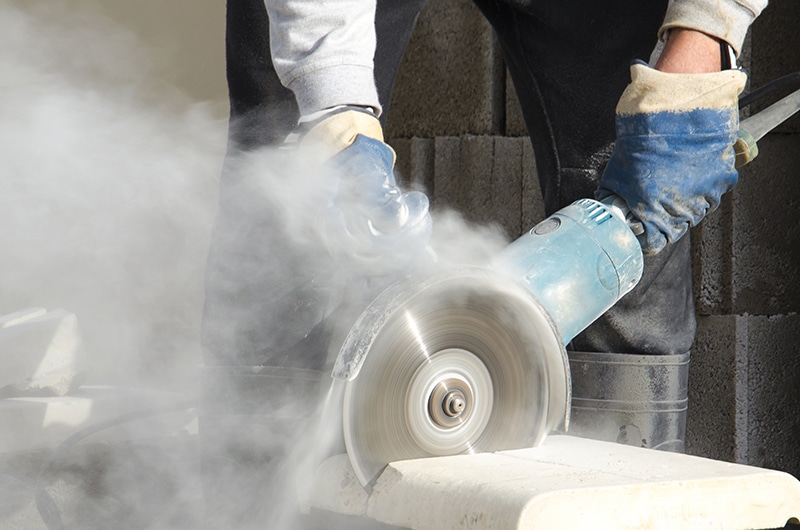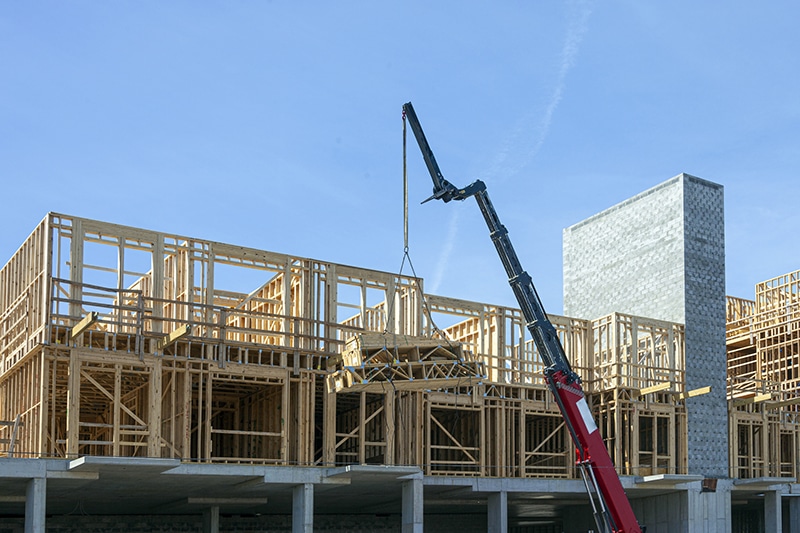You could save yourself hundreds of thousands of dollars by getting this right.
True or False:
The U.S. completely banned the use of asbestos in building materials in 1989. That means any commercial building constructed in 1990 or later poses no asbestos risk.
Consequently, you don’t need to worry about getting an asbestos survey prior to renovation or restoration projects on buildings erected in the past 30 years – right?
False.
The “asbestos is no longer used” myth potentially exposes commercial property owners to fines of $25,000 per day when they unwittingly disturb materials containing asbestos.
Falling for the lie that “newer buildings” are automatically in the clear is not a defense.
Should You Get an Asbestos Survey or Not?
Commercial building owners usually take one of three paths when renovations or restorative construction work requires the disturbance of building materials:
- They continue to act as if newer buildings don’t require an asbestos survey. This may save time and money in the short run, but the financial, legal, and health risks intrinsic in this “head in the sand” approach aren’t even remotely justified.
- They proceed under the assumption that asbestos is definitely present. This method is the costliest, but can get the work underway quicker and should provide protection from fines and litigation. You will still need to alert the proper governing bodies of your intentions.
- They hire a licensed environmental consultant to conduct an asbestos survey of the jobsite prior to beginning the project. The aim is not so much to find asbestos, but to try to prove that asbestos is not present. If the survey results are clear of asbestos, the owner can proceed without the added expense of special personnel, equipment, and procedures.
My aim here is to explain why asbestos is still a major concern and convince you to take the laws governing commercial building demolition or renovation seriously. Some commercial building owners, managers, and contractors have ignored regulations at considerable risk to their businesses and to the public health.
I’ll focus specifically on Southern California asbestos regulations, but the principles here apply to construction projects and properties nationwide. You should always check with local governing bodies before proceeding with any commercial building restoration or renovation project.
An asbestos survey is usually the first step you should take.

Why Are Asbestos Surveys Required?
Studies linking asbestos exposure to lung cancer gained widespread public attention in the 1970’s and led to a series of regulations intended to address the danger. The 1989 Asbestos Ban and Phase-Out Rule by the Environmental Protection Agency appeared to signal the end of asbestos-containing products in the United States.
They were to be totally banned.
Unfortunately, once the matter seemed settled, the nation’s attention turned to other matters, and the landmark 1991 decision by the Fifth Circuit Court of Appeals that struck down major parts of the EPA’s rule barely made the press.
Consequently, many of the materials used to construct your building (regardless of its age) may still contain asbestos.
These items, for instance, are prime suspects:
- Pipeline wraps
- Roofing felt
- Vinyl floor tile
- Millboard
- Roof coatings
That list could be extended to cement corrugated sheet, cement flat sheet, and further – but my aim isn’t to provide an exhaustive picture of the possibilities.
My hope is that you will realize how serious the situation is – both from a financial and environmental health standpoint – and exercise due diligence the next time a project in or on your building requires a disturbance of construction materials.
Again, the 1991 decision rendered the 1989 asbestos ban irrelevant in many ways. There’s still plenty of room for concern about asbestos in commercial building, and the smartest place to start is almost always with an asbestos survey.
Depending on the project type and size, asbestos surveys can typically be conducted quickly and inexpensively. The procedure will identify any asbestos-containing materials (ACMs) present or potentially clear the site as free of ACMs. This is definitely a case of “forewarned is forearmed.”
What Do California Asbestos Regulations Require?
Your commercial building renovation or restoration project will potentially be affected by regulations at every level of government, beginning with the EPA and continuing down to your city or county.
It’s critical that you understand one major point:
The asbestos survey is necessary regardless of the age of the building.
Let’s look at the language in two of the most-discussed California asbestos regulations: San Diego Air Pollution Control District Rule 1206 and SCAQMD Rule 1403. Then, we’ll cover two asbestos regulations specific to Northern California: Sacramento Metro Air Quality Management District Rule 902 and Bay Area Air Quality Management District Regulation 11, Rule 2.
San Diego APCD Asbestos Rule 1206
Facility survey requirements under Rule 1206 Section (d) state the following:
Prior to commencement of renovation or demolition operations and prior to submitting the notifications required by Section (e), a facility survey shall be performed to determine the presence or absence of ACM, regardless of the age of the facility. Suspect materials that will be removed, stripped, or disturbed by the renovation or demolition operations shall be sampled and analyzed for asbestos content. Once the renovation or demolition notification has been submitted, the facility survey shall be made immediately available to the District upon request.
Suspect materials essentially include anything but wood, metal, or glass. To be declared an asbestos-containing material (ACM) covered by Rule 1206, the asbestos level must be greater than one percent. Only an asbestos survey (asbestos testing) can clear suspect materials as non-ACM.
Rule 1206 does make provision for emergency operations, but only for the waiting period before the work begins – not for the necessity of an asbestos survey (except for assumed ACM presence).
Please note the Section quoted above states that an asbestos survey is required prior to the commencement of work “regardless of the age of the facility.”
SCAQMD Rule 1403 (Greater Los Angeles Area)
The stated purpose of Rule 1403 is to “specify work practice requirements to limit asbestos emissions from building and facility demolition and renovation activities.” The Rule applies to both the property owners and any other entities hired to conduct demolition or renovation activity that could potentially disturb asbestos-containing materials.
Under Section (d) of Rule 1403, requirements for the facility survey for asbestos are listed. Those requirements include the following:
- The asbestos survey must be conducted by a Certified Asbestos Consultant
- The survey must be completed prior to any demolition or renovation activity
- There are no exceptions based on date of construction or the age of the facility, as noted in the FAQ published for the regulation.
The two Rules have similar intent and share some similar wording. Both require you to contract with a licensed asbestos consultant to survey the intended site prior to disturbance of any materials possibly containing asbestos (Rule 1206 provides an exemption if you assume all materials to be disturbed materials are ACMs). Both give provision for emergency situations.
A primary difference is that Proposed Rule 1403 stipulates that any uncontrolled disturbance of asbestos-containing materials (such as fire) demands special procedures, whether the affected area is large or small.
Sacramento and Bay Area Asbestos Regulations
Contractors working on projects in Northern California should review these two documents: Sacramento Metro Air Quality Management District Rule 902 and Bay Area Air Quality Management District Regulation 11, Rule 2. The differences between requirements in these two rulings are subtle and primarily apply to the listed exemptions (renovation size thresholds for required testing, for example), so you will want to check before proceeding with your project. There are also different notification and reporting procedures for each region.
Unlike the Southern California asbestos regulations covered above, Northern California’s don’t explicitly address building age as it relates to survey requirements; however, it is well understood by regulators and consultants that a survey is always required prior to renovation or demolition, since no age exemption is provided in either regulation.
Since both documents are extensive, anyone working with asbestos should check to make sure of compliance before beginning the job. That is true whether you are demolishing a structure, abating an asbestos situation, disposing of asbestos, or even maintaining highways with materials containing asbestos. Always check the applicability and exemptions to determine your responsibility.

Does My Project Require an Asbestos Survey?
There is a simple way to forego the asbestos survey (in many jurisdictions):
Treat the site as if asbestos is definitely present and hire a licensed asbestos removal team. If cost is not an issue, you can begin with a worst-case assumption and treat every bit of the disturbed material as if it is contaminated with asbestos.
Unfortunately, some commercial property owners and managers don’t do anything about asbestos at all. They begin with a best-case assumption – but without proof to back up their beliefs. Many don’t realize that disturbing a potential ACM without first conducting an asbestos survey to clear the material puts them in direct violation of the law.
Why do they show such a lack of concern for the health of their employees, the contractors they hire, and the people they serve?
It’s often a case of otherwise intelligent owners or managers falling for the myth I mentioned earlier. They don’t contract for a survey because they are certain that asbestos was banned from construction materials several decades ago.
Unfortunately, they’re wrong.
What Can Happen If I Don’t Get an Asbestos Survey?
Bad things can happen if you don’t get the required asbestos survey prior to the disturbance of materials that may contain asbestos.
Consider this example from the Colorado U.S. Attorney’s Office:
A capital management firm in Colorado pled guilty to charges related to an illegal release of asbestos during renovation of an apartment complex. The firm failed to obtain the required pre-work asbestos survey, thereby causing release of asbestos into the air.
A principal of the firm received an 8-month prison sentence and a $100,000 fine. The firm must also pay for medical assistance for those who were exposed to asbestos.
Failing to get a pre-renovation or pre-demolition asbestos survey puts you at risk of stiff fines, business disruption, a tarnished image, civil litigation or even criminal prosecution.
Here’s another case that might have been avoided with an asbestos survey:
Workers in Portland, Oregon, sued a property management company because of issues related to alleged asbestos exposure during a renovation at an apartment complex. The complaint says construction crew members were told “there was no asbestos”, but after-the-fact asbestos testing allegedly showed otherwise.
When and How to Schedule an Asbestos Survey
Licensed asbestos survey consultants are a phone call away. Of course, exercise due diligence to make sure the company you hire is registered and approved to do business in your locality.
If you don’t know of a capable environmental consultant in your area, call Forensic Analytical Consulting Services (FACS) at (888) 711-9998. We maintain offices coast-to-coast and can either help you ourselves or point you to a qualified consultant near you.
There’s too much at stake here to ignore the possibility that ACMs are present in your commercial structure – even if it was built this year.
Get the word out to every commercial building owner and manager you know:
Asbestos is still in use, and it can still cause damage – damage to people and damage to companies. Don’t be the next victim of the “Asbestos was banned years ago” myth.